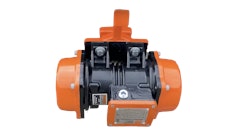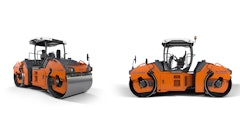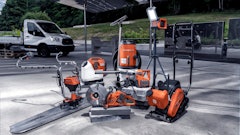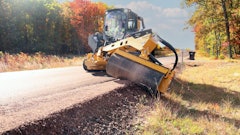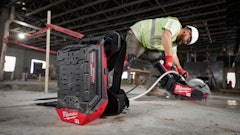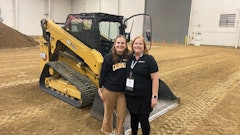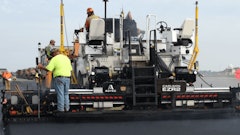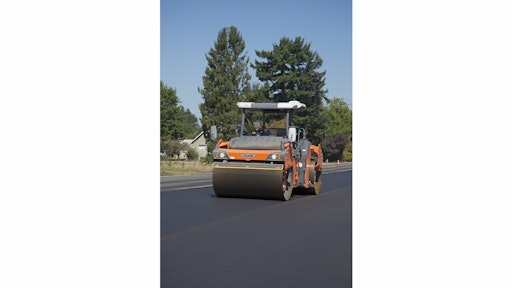
The final Federal Highway Administration-sponsored intelligent compaction and in-place HMA Density Project took place in August at a Canadian border crossing in northwest Washington State, and a new Hamm HD+ 140i VV outfitted with the Hamm Compaction Quality (HCQ) IC system played a big role.
As part of its Every Day Counts initiative for fast-tracking research of immediate benefit to the highway community, FHWA has been coordinating and directing research in both asphalt and soil (subgrade) intelligent compaction (IC).
Both Hamm and Caterpillar Inc. participated in the IC density correlation testing in the Washington State DOT project.
Today’s asphalt IC machines are vibratory rollers with accelerometers mounted on the axles of drums, global positioning system, infrared temperature sensors (for asphalt), and on-board computers that can display color-coded maps in real-time to track roller passes, asphalt surface temperatures, and stiffness of compacted materials.
Why is there national interest in asphalt intelligent compaction? FHWA lists a number of benefits. To begin, IC optimizes labor deployment and construction time. Contractors can match the right amount of asphalt with the right amount of compactive effort on each pass to ensure long-term performance.
Ultimately, FHWA says, IC will lead to lower costs of compaction and maintenance requirements. The flexibility to make fewer passes to achieve the correct compaction level will minimize fuel use and equipment wear and tear.
“With being more consistent in our roller passes, we can also expect smoother rides and longer-lasting pavements,” said Tim Kowalski, applications support manager for Hamm.
IC also provides contractors the ability to make midcourse corrections. Adjustments during compaction of one layer before additional layers are placed makes sure lower lift problems don’t affect the final road surface.
Lastly, IC improves the ability of contractors to maintain real-time construction records. Data from the IC, along with the requisite GPS or differential global navigation system satellite (DGNSS) coordinates of compaction activity, can be downloaded into construction quality databases and stored for future reference.
For double-drum asphalt intelligent compaction – as well as single-drum soil compaction – field data measurement usually is accelerometer-based, with the gauge located on the drum motor inside the rubber buffers on the roller frame.
For each manufacturer’s system, FHWA requires an intelligent compaction measurement value (ICMV, principally a stiffness measurement), a GPS-based documentation system, an onboard color-coded display, a surface temperature measurement system for asphalt rollers only, and raw data that are Veda-compatible.
Veda 2.1 is a map-based tool for viewing and analyzing geospatial data, and is the software around which all IC activity revolves. Veda can import data from various intelligent compaction equipment to perform editing, data layering, point testing, and analysis; Veda displays compaction information in easy-to-read formats, including graphs and maps.
Veda’s functionality includes viewing and analyzing IC and other related geospatial data. You can overlay the data onto a map of the site, perform various statistical analyses, and create reports.
IC data flow consists of data collection, data transfer, and data processing. Now, data analysis options have been enhanced with a new Veda export function, which exports recorded data in a standardized format required today for documentation purposes on many construction sites in North America. Read more about Veda or download the program at intelligentcompaction.com.
Stiffness = Density?
While IC systems as implemented can measure the number of passes and lift temperature for any spot on a lift, they are unable to detect pavement density on the fly. The “Holy Grail” of asphalt intelligent compaction is the ability to obtain density while the roller is in motion, but current technology doesn’t allow it.
Instead, lift density in IC operations is being extrapolated from measurements of lift stiffness, which are obtained from the accelerometer. To-date, equipment manufacturers have been unable to consistently relate the measurement of buildup of stiffness beneath a drum to an actual density value; instead they use their own measurement values for stiffness, and are trying correlate stiffness data acquired during intelligent compaction activity with nationally accepted density specifications. Every maker has its own nomenclature: Hamm calls its stiffness measurement value the HMV.
In action, vibrations from the accelerometer are processed to estimate the stiffness of the material being compacted. Global positioning system receivers are used to record the location of the roller at each instant, and these readings are used to provide as-built maps showing process information such as number of roller passes, roller path, and subgrade stiffness in real-time to the operator.
The inability to directly relate stiffness measurement values from the accelerometer or other process to actual engineering values stands in the way to use of IC for asphalt compaction for quality assurance or acceptance.
“Consistently reliable correlation between intelligent compaction measurement values (ICMV) and in situ density readings have not been established,” said FHWA’s Michael Arasteh, Office of Technical Services, Baltimore, at a workshop in January 2014. “On many projects, there has been a ‘relationship’ between ICMV and density,” he added, but the firm, reliable link is not yet there.
The major purpose of the FHWA/state DOT-sponsored projects from 2012-14 has been to see if the stiffness measurement values of different manufacturers can be correlated into density readings.
Global Positioning Systems
As stated, both Hamm and Caterpillar participated in the IC density correlation testing in the Washington State DOT project. Hamm HD+ 140i VV and Caterpillar CB54 XW rollers were utilized in the research.
The land-based global positioning system used by most manufacturers offers real-time kinematic (RTK) precision via a GPS base station, GPS radio and roller-mounted receiver, and a GPS rover, all connected by radio signals.
Hamm, however, eschews this system’s setup by using the proprietary, subscription-based OmniSTAR HP system, which should provide location precision of 2 to 4 in. directly from the differential global navigation system satellites (GNSS), operating in real time, and without the need for local base stations or telemetry links. This eliminates the need to set up and move the base station and rover as work progresses.
At the operator-end, the Hamm system consists of a roof-mounted GPS receiver, and cabin interior-mounted PC/touch screen, and an exterior-mounted “black box”.
With the HCQ Navigator (for Hamm Compaction Quality), Hamm was one of the first manufacturers to launch a compaction measurement and documentation system. The system links measurement data from various sensors on the rollers with the position information obtained via GNSS (global navigation satellite system) receivers. The HCQ Navigator utilizes these data to determine the progress of compaction for all rollers in a group in real time. A compaction map visualizes the status for the roller drivers and site management.
“HCQ Premium is the latest intelligent compaction system from Hamm,” says Tim Kowalski, Hamm applications support manager. “We have upgraded the system to provide pre-installation kits for any soil or HD+ Hamm roller, if not already factory-equipped.”
The kit is required to transfer the receiver and computer tablet from one machine to the next, so as to identify the size and type of roller, and to correct the offset from where the receiver is mounted on the roof, to the center of the drum. “This provides extreme accuracy for position and better utilization for the contractor, and is a Hamm exclusive for our H i-series soil compactors and HD+ and HD+ i-series asphalt rollers,” Kowalski says.
The individual HCQ Premium system modules (GPS/GNSS receiver and panel PC tablet) can be swapped at will between soil compactors, asphalt tandem, and pneumatic (rubber-tired) rollers. That’s because the HCQ Navigator works with the same components on both soil and asphalt compactors.
Clear dialogues and icons make the HCQ system extremely simple to operate. The plug-and-play solution with automatic machine detection eliminates complicated parameter settings.
“Once work is complete, the data that were generated can be easily backed up via the USB interface,” Kowalski said. “The resulting data provide documentation of the continuous compaction control, with no need for transformation or further processing. Data collection and backup also serve as a basis for individual evaluation and preparation of statistics.”
At the core of the application is a rugged panel touch-screen PC with USB interface. This computer provides processing power as well as a monitor and data storage facilities. It is based on military standards, has a fully enclosed metal case, and is protected against water and vibrations.
The differential global navigation system receiver is a heavy-duty version with magnetic feet, and only takes seconds to mount on the template on the roof of the roller. This device receives the satellite signals, along with a DGNSS correction signal. Licenses for these signals are available in different accuracy classes by subscription.
The HCQ Navigator retains the GPS signal for up to 16 hours even after the machine is shut down; this eliminates wait time for system initialization when starting work, after breaks, at the start of shifts, etc. When compacting under bridges or in locations with radio shadowing, sensors combine with the intelligent software to bridge over insufficient GPS signals for up to one minute.
The HCQ Indicator measures the stiffness of asphalt or soil beneath the drum, and consists of an accelerometer, a processor and a display. Based on these data, the processor calculates the HMV (Hamm measurement value) – indicating the degree of compaction as a stiffness measurement derived from the measured signals – and displays this value to the driver in the cab.
A WLAN data network can be used to interconnect a group of rollers so they can exchange measurement results continuously. Each of the roller operators can watch the current progress of the group’s work, e.g. the number of passes by all of the rollers, achieved mat stiffness, or mat temperature.
During the compaction process, the panel PC shows the operator how stiffness is progressing. Separate graphics depict, for example, the number of completed passes or the current asphalt temperature, and the operator has the ability to monitor two of these functions simultaneously on the split screen.
Final test in Washington State
As powerful as the Hamm HCQ system is, like other manufacturers’ systems, it still cannot quantitatively relate achieved stiffness with actual density, as measured by cores and density gauges.
As the final event in the correlation investigation, the S.R. 539/Lynden-Aldergrove Port of Entry Improvements workshop was the last of a series of field trials quarterbacked by FHWA from 2012 to 2014, as it attempts to pinpoint the relationship between in-place HMA density and IC roller operations settings and density measurements.
S.R. 539 was a joint project between Washington State DOT and the Canada Border Services Agency. The project length was 2,500 ft. with three lanes of construction, widths ranging from 13 to 14 ft. The contractor was Granite Construction.
A final report is forthcoming later in 2014. Visit intelligentcompaction.com for more information.









